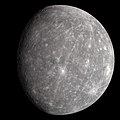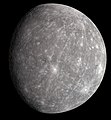Òbrôzk:Mercury in true color.jpg

Miara pòdzérkù – 600 × 600 pikslów. Jinszy rozdzélnotë: 240 × 240 pikslów | 480 × 480 pikslów | 768 × 768 pikslów | 1040 × 1040 pikslów.
Pierwòtny lopk (1040 × 1040 pikslów, miara lopka: 408 KB, ôrt MIME: image/jpeg)
Historëjô lopka
Klëkni na datum/czas, abë òbaczëc jak wëzdrzôł lopk w tim czasu.
| Datum/Czas | Miniatura | Miara | Brëkòwnik | Òpisënk | |
|---|---|---|---|---|---|
| aktualny | 10:16, 15 môj 2023 |  | 1040 × 1040 (408 KB) | CactiStaccingCrane | Reverted to version as of 10:42, 24 July 2022 (UTC) |
| 10:01, 15 môj 2023 |  | 1024 × 1024 (837 KB) | CactiStaccingCrane | Manually merge the original monochrome image with the calibrated color image to eek out more resolution | |
| 12:42, 24 lëp 2022 |  | 1040 × 1040 (408 KB) | JCP-JohnCarlo | Make this planet image center | |
| 12:25, 24 lëp 2022 |  | 1040 × 1040 (710 KB) | JCP-JohnCarlo | Canvas image | |
| 11:00, 3 lës 2019 |  | 960 × 1040 (865 KB) | Mirecki | User created page with UploadWizard |
Lënczi do lopka
Hewò są starnë, jaczé òdwòłëją sã do negò lopka:
Globalné wëzwëskanié lopka
Nene lopk je téż brëkòwnóny w jinnych ùdbach Wiki:
- Wëzwëskanié w af.wikipedia.org
- Wëzwëskanié w als.wikipedia.org
- Wëzwëskanié w ar.wikibooks.org
- Wëzwëskanié w as.wikipedia.org
- Wëzwëskanié w be-tarask.wikipedia.org
- Wëzwëskanié w beta.wikiversity.org
- Wëzwëskanié w bn.wikibooks.org
- Wëzwëskanié w bo.wikipedia.org
- Wëzwëskanié w br.wikipedia.org
- Wëzwëskanié w ceb.wikipedia.org
- Wëzwëskanié w ckb.wiktionary.org
- Wëzwëskanié w cv.wikipedia.org
- Wëzwëskanié w cy.wikipedia.org
- Wëzwëskanié w de.wikipedia.org
- Wëzwëskanié w dty.wikipedia.org
- Wëzwëskanié w dz.wikipedia.org
- Wëzwëskanié w eml.wikipedia.org
- Wëzwëskanié w en.wikipedia.org
- Mercury (planet)
- Terrestrial planet
- The Planets
- Timeline of discovery of Solar System planets and their moons
- List of Solar System objects by size
- List of gravitationally rounded objects of the Solar System
- User:Kwamikagami/sandbox
- NASA
- User:Kazkaskazkasako/Books/Physical sciences
- Talk:Mercury (planet)/Archive 3
- User:Nrco0e/Userboxes
- User:Applekle/sandbox
- Wikipedia:Userboxes/Location/Extraterrestrial
- Talk:The Planets/GA1
- User:Double sharp/Largest Solar System objects
- User:TomMasterReal
- User:Nrco0e/Userboxes/FavMercury
- User:KeroseneLover100/sandbox/sandbox
- Wëzwëskanié w en.wikibooks.org
- Wëzwëskanié w en.wiktionary.org
- Wëzwëskanié w eo.wikipedia.org
- Wëzwëskanié w es.wikipedia.org
Pòkôżë lëstã glonal;negò brëkwaniô negò lopka.

